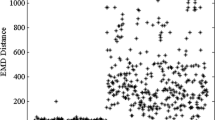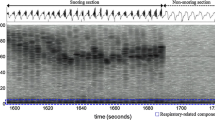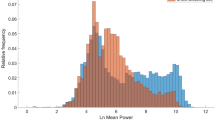Abstract
Purpose
Snoring patients seeking medical assistance represent a wide range of clinical and sleep study findings from nonsleepy nonapneic snoring to severe obstructive sleep apnea syndrome. The prevalence of snoring is high and it significantly impacts quality of life. Its objective diagnosis usually requires a sleep study. We developed a system to analyze snoring sounds with a Moving Picture Experts Group Layer-3 Audio (MP3) recorder device and present its value in the screening of snoring.
Methods
We recorded snoring sounds during in-lab polysomnography (PSG) in 200 consecutive patients referred for a suspicion of obstructive sleep apnea. Snoring was recorded during the PSG with two microphones: one attached to the throat and the other to the ceiling; an MP3 device was attached to the patient’s collar. Snoring was confirmed when the MP3 acoustic signal exceeded twice the median value of the acoustic signal for the entire recording. Results of the MP3 snoring recording were compared to the snoring recordings from the PSG.
Results
MP3 recording proved technically successful for 87% of the patients. The Pearson correlation between PSG snoring and MP3 snoring was highly significant at 0.77 (p < 0.001). The MP3 recording device underestimated the snoring time by a mean ± SD of 32 ± 55 min.
Conclusions
The recording of snoring with an MP3 device provides reliable information about the patient’s snoring.




Similar content being viewed by others
Abbreviations
- AHI:
-
Apnea and hypopnea index
- AUC:
-
Area under the curve
- AUDIT:
-
Alcohol Use Disorders Identification Test
- BMI:
-
Body mass index
- DEPS:
-
Depression Scale
- ESS:
-
Epworth Sleepiness Scale
- MP3:
-
Moving Picture Experts Group Layer-3 Audio
- OSA:
-
Obstructive sleep apnea
- PSG:
-
Polysomnography
- ROC:
-
Receiver-operating curve
References
Svensson M, Franklin KA, Theorell-Haglow J, Lindberg E (2008) Daytime sleepiness relates to snoring independent of the apnea–hypopnea index in women from the general population. Chest 5:919–924
Baldwin CM, Ervin AM, Mays MZ, Robbins J, Shafazand S, Walsleben J, Weaver T (2010) Sleep disturbances, quality of life, and ethnicity: the sleep heart health study. J Clin Sleep Med 2:176–183
Bliwise DL, Nekich JC, Dement WC (1991) Relative validity of self-reported snoring as a symptom of sleep apnea in a sleep clinic population. Chest 3:600–608
Stuck BA, Abrams J, de la Chaux R, Dreher A, Heiser C, Hohenhorst W, Kuhnel T, Maurer JT, Pirsig W, Steffen A, Verse T (2010) Diagnosis and treatment of snoring in adults—S1 guideline of the german society of otorhinolaryngology, head and neck surgery. Sleep Breath 14(4):317–21
Deegan PC, McNicholas WT (1996) Predictive value of clinical features for the obstructive sleep apnoea syndrome. Eur Respir J 1:117–124
Maimon N, Hanly PJ (2010) Does snoring intensity correlate with the severity of obstructive sleep apnea? J Clin Sleep Med 5:475–478
Romero E, Krakow B, Haynes P, Ulibarri V (2010) Nocturia and snoring: predictive symptoms for obstructive sleep apnea. Sleep Breath 4:337–343
Kohler M, Stradling JR (2010) Mechanisms of vascular damage in obstructive sleep apnea. Nat Rev Cardiol 12:677–685
Amatoury J, Howitt L, Wheatley JR, Avolio AP, Amis TC (2006) Snoring-related energy transmission to the carotid artery in rabbits. J Appl Physiol 5:1547–1553
Cho JG, Witting PK, Verma M, Wu BJ, Shanu A, Kairaitis K, Amis TC, Wheatley JR (2011) Tissue vibration induces carotid artery endothelial dysfunction: a mechanism linking snoring and carotid atherosclerosis? Sleep 6:751–757
Rice TB, Strollo PJ Jr (2011) A nuisance or nemesis: the adverse effects of snoring. Sleep 6:693–694
Virkkula P, Bachour A, Hytonen M, Malmberg H, Salmi T, Maasilta P (2005) Patient- and bed partner-reported symptoms, smoking, and nasal resistance in sleep-disordered breathing. Chest 4:2176–2182
Virkkula P, Bachour A, Hytonen M, Salmi T, Malmberg H, Hurmerinta K, Maasilta P (2006) Snoring is not relieved by nasal surgery despite improvement in nasal resistance. Chest 1:81–87
Hoffstein V, Mateika S, Anderson D (1994) Snoring: is it in the ear of the beholder? Sleep 6:522–526
Hoffstein V, Mateika S, Nash S (1996) Comparing perceptions and measurements of snoring. Sleep 10:783–789
Pang KP, Dillard TA, Blanchard AR, Gourin CG, Podolsky R, Terris DJ (2006) A comparison of polysomnography and the sleepstrip in the diagnosis of OSA. Otolaryngol Head Neck Surg 2:265–268
(1997) Practice parameters for the indications for polysomnography and related procedures. Polysomnography Task Force, American Sleep Disorders Association Standards of Practice Committee. Sleep 6:406–422
Kushida CA, Littner MR, Morgenthaler T, Alessi CA, Bailey D, Coleman J Jr, Friedman L, Hirshkowitz M, Kapen S, Kramer M, Lee-Chiong T, Loube DL, Owens J, Pancer JP, Wise M (2005) Practice parameters for the indications for polysomnography and related procedures: an update for 2005. Sleep 4:499–521
Flemons WW, Douglas NJ, Kuna ST, Rodenstein DO, Wheatley J (2004) Access to diagnosis and treatment of patients with suspected sleep apnea. Am J Respir Crit Care Med 6:668–672
Collop NA, Anderson WM, Boehlecke B, Claman D, Goldberg R, Gottlieb DJ, Hudgel D, Sateia M, Schwab R (2007) Clinical guidelines for the use of unattended portable monitors in the diagnosis of obstructive sleep apnea in adult patients. Portable monitoring task force of the american academy of sleep medicine. J Clin Sleep Med 7:737–747
Anttalainen U, Liippo K, Saaresranta T (2011) Diagnosis and initiation of nasal continuous positive airway pressure therapy for OSAS without a preceding sleep study? Sleep Breath 4:791–797
Rechtschaffen A, Kales A (1968) A manual of standardized terminology, techniques and scoring system for sleep stages of human subjects. BIS/BIR UCLA, Los Angeles
Iber C, Ancoli-Israel S, Chesson A, Quan SF (eds) (2007) The AASM manual for the scoring of sleep and associated events: rules, terminology, and technical specification. American Academy of Sleep Medicine, Westchester
Maasilta P, Bachour A, Teramo K, Polo O, Laitinen LA (2001) Sleep-related disordered breathing during pregnancy in obese women. Chest 5:1448–1454
Salmi T, Telakivi T, Partinen M (1989) Evaluation of automatic analysis of SCSB, airflow and oxygen saturation signals in patients with sleep related apneas. Chest 2:255–261
Bland JM, Altman DG (1986) Statistical methods for assessing agreement between two methods of clinical measurement. Lancet 8476:307–310
Ruehland WR, O’Donoghue FJ, Pierce RJ, Thornton AT, Singh P, Copland JM, Stevens B, Rochford PD (2011) The 2007 AASM recommendations for EEG electrode placement in polysomnography: impact on sleep and cortical arousal scoring. Sleep 1:73–81
Moser D, Anderer P, Gruber G, Parapatics S, Loretz E, Boeck M, Kloesch G, Heller E, Schmidt A, Danker-Hopfe H, Saletu B, Zeitlhofer J, Dorffner G (2009) Sleep classification according to AASM and Rechtschaffen & Kales: effects on sleep scoring parameters. Sleep 2:139–149
Fiz JA, Abad J, Jane R, Riera M, Mananas MA, Caminal P, Rodenstein D, Morera J (1996) Acoustic analysis of snoring sound in patients with simple snoring and obstructive sleep apnoea. Eur Respir J 11:2365–2370
Wilson K, Stoohs RA, Mulrooney TF, Johnson LJ, Guilleminault C, Huang Z (1999) The snoring spectrum: acoustic assessment of snoring sound intensity in 1,139 individuals undergoing polysomnography. Chest 3:762–770
Morris LG, Kleinberger A, Lee KC, Liberatore LA, Burschtin O (2008) Rapid risk stratification for obstructive sleep apnea, based on snoring severity and body mass index. Otolaryngol Head Neck Surg 5:615–618
Li QY, Huang SG, Li M, Liu JL, Wan HY (2009) BMI is an independent risk factor for snoring in Chinese women aged over 30 years. Sleep Breath 3:289–293
Nagayoshi M, Yamagishi K, Tanigawa T, Sakurai S, Kitamura A, Kiyama M, Imano H, Ohira T, Sato S, Sankai T, Iso H, Investigators CIRCS (2011) Risk factors for snoring among Japanese men and women: a community-based cross-sectional study. Sleep Breath 1:63–69
Pevernagie D, Aarts RM, De Meyer M (2010) The acoustics of snoring. Sleep Med Rev 2:131–144
Nigro CA, Dibur E, Aimaretti S, Gonzalez S, Rhodius E (2011) Comparison of the automatic analysis versus the manual scoring from ApneaLink device for the diagnosis of obstructive sleep apnoea syndrome. Sleep Breath 4:679–686
Acknowledgments
This study has benefited from the financial support of the following non-profit organizations in Finland: the Research Foundation for Respiratory Diseases, the Finnish Anti-Tuberculosis Association Foundation, the Väinö and Laina Kivi Foundation, Jalmari and Rauha Ahokas Foundation, Sleep Research Society of Finland, and the University of Helsinki Funds.
Conflict of interest
Tapani Salmi has been a medical adviser and consultant for SmartValley Software Oy and owns shares of the company. Hanna-Riikka Kreivi, Paula Maasilta, and Adel Bachour declare that they have no conflict of interest.
Author information
Authors and Affiliations
Corresponding author
Rights and permissions
About this article
Cite this article
Kreivi, HR., Salmi, T., Maasilta, P. et al. Screening of snoring with an MP3 recorder. Sleep Breath 17, 77–84 (2013). https://doi.org/10.1007/s11325-012-0652-z
Received:
Revised:
Accepted:
Published:
Issue Date:
DOI: https://doi.org/10.1007/s11325-012-0652-z




